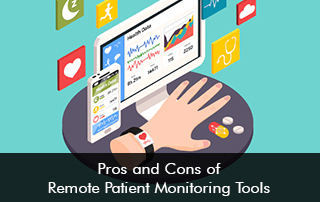The COVID-19 pandemic has caused healthcare organizations to embrace remote care models to ensure patients receive prompt care without having to visit the provider’s clinic. Remote patient monitoring (RPM) technology makes it possible to monitor a patient’s condition without an in-office visit.
How does remote patient monitoring work?
Remote patient monitoring tools leverage technology to monitor different patient conditions like vital signs, blood pressure, and heart rate outside the hospital setting. RPM uses devices to gather this information and transmit it to physicians in real time. Patient data is sent to the doctor’s office through a telehealth computer system or software application that can be installed on personal devices and computers.
Examples of remote patient monitoring tools
Remote patient monitoring (RPM) technology includes the following,
- Blood pressure monitors.
- Glucose meters for patients with diabetes.
- Surveillance monitors can locate patients with dementia and alert clinicians.
- Remote infertility monitoring.
- Diet logging programs.
- At-home tests to keep patients suffering from substance abuse on the right track.
Benefits of RPM technology
The Insider Intelligence projects that 70.6 million patients in the United States will benefit from remote patient monitoring technology by the year 2025. Patients are also in favor of using RPM tools and want their providers to incorporate them into their existing care plans.
- Clinicians get health data in real-time – Efficient care can be offered to patients as providers can receive patient data in real-time related to glucose levels, heart rate, etc. This helps physicians to make any changes in prescription and alert them to any serious health conditions and take quick action to improve health outcome levels.
- Convenience and improved quality of life for patients – Patients having chronic diseases or underlying health conditions are spared from visiting the hospital thanks to the robust technology of remote patient monitoring. Patients can now stay at home and close to their loved ones as they are being observed through devices. Clinicians want to take advantage of Telemedicine EMR Software, including RPM for effective chronic care management.
- Increased accessibility – Remote patient monitoring tools make healthcare more accessible. For example, elderly patients who have mobility issues can still get monitored for their underlying conditions.
- Cost advantage – One of the major advantages of RPM technology is that it is a cost-effective solution. Patients don’t have to visit the provider so often which saves costs. Operational costs can also go down as in-office staff hours can reduce as the number of patient visits decline.
Cons of remote patient monitoring technology
The cons are few as compared to the advantages of the powerful solution.
- Connectivity barricades with patients – Since RPM devices transfer health data in real-time internet connectivity is required. Not all patients have access to a stable internet connection.
- RMP tools require new software – Remote patient monitoring acquires a lot of data for every patient. This may require the provider to invest in cloud-storage options. Fortunately, the boom in RPM technology means that top-ranked Electronic Health Records (EHR) software integrates seamlessly with RMP technologies.
Summing it up RPM solutions are a critical part of healthcare making way for efficiencies and improving patient outcome levels. Patients can get better care from the comfort of their homes which helps enhance their quality of life.






